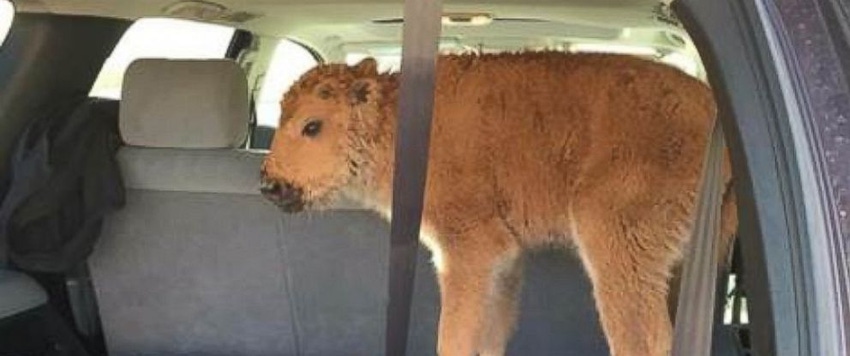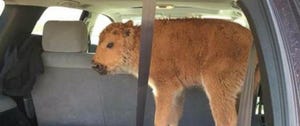May 25, 2016

A few weeks ago, tourists picked up an abandoned bison calf in Yellowstone and hauled the animal in their car to area officials in hopes of finding help for the baby. They thought the calf looked cold and needed assistance.
The action was unlawful, unnecessary and delighted the media, which was keen to share the news that park rangers euthanized the calf after it was turned over by the tourists to officials. People were outraged, and journalists had a field day writing about humane treatment of animals. Here are four things I think the tourists, the media and online commenters missed about the situation:
1. The Yellowstone bison herd is mismanaged and overpopulated

Photo Credit: Karen Olsen Richardson
Ask ranchers in the area, and they’ll be quick to tell you that the bison herd numbers have completely surpassed the numbers that are allowed in the park. From what I’ve been told, the herd numbers shouldn’t be more than 2,500, yet more than 5,500 roam the park and the surrounding pastures, which are typically managed by local ranchers.
This leads to overgrazing and impacts other species in the park ranging from elk to beavers to bees. I don’t mean to sound heartless to the people who fell in love with this bison calf, but the reality is that nature is a cruel beast, and not every animal thrives in the wild. Is one less bison calf really “a tragedy,” as the media is calling it?
2. Brucellosis is a major issue in the Yellowstone bison herd
According to USDA’s APHIS, “More than 50% of the bison in Yellowstone National Park test positive for brucellosis. A positive test indicates that animals have been exposed and are most likely infected. The concern is that when these bison leave the park, they may transmit brucellosis to cattle in the surrounding states.”
The bison have also infected the elk population, and ranchers have told me that grazing their cattle near the park is no longer worth the risk because of the devastation it could cause to their herds if exposed to a brucellosis-infected bison cow.
3. The tourists’ decision to move the bison calf was illegal and dangerous
Never mind the fact that the mama bison could have been right around the corner and could have hurt the tourists or damaged their vehicle in their rescue attempt, it’s also very illegal to mess with the wildlife found in the park; plus, it increased the risk of brucellosis spreading to the surrounding brucellosis-free states.
In an ABC News article, Charissa Reid, Yellowstone public affairs, said, “You have to understand that we're not in the business of animal rescue. It’s also illegal to transport wild bison outside the park without having them tested and monitored for brucellosis. The park just doesn't have the facility or capacity to quarantine, test and monitor the calf. It was just a very inhumane situation. The calf was either going to starve to death, get sick, get hit or cause an accident, so we had to make the difficult decision to put it down.”
4. Tourists need to be mindful that they, too, are disrupters in nature
It’s very easy to be sympathetic to an abandoned bison calf on the side of the road when you’re in your air-conditioned car on a vacation from the concrete jungle. And it’s easy to cry over the poor dogs and cats when you watch those animal rights activists’ commercials begging for money, but consumers often forget that taking care of these animals requires a lot of time, money and labor. While it’s easy to point fingers from afar, I have to ask how many of these folks would have been willing to offer refuge to the bison calf in their own homes or back yards?
What’s more, while tourists pay fees that can help support places like Yellowstone National Park, any time a tourist decides to interfere with nature when visiting public parks — whether that’s loading up a bison calf in the back of an SUV or dumping litter on the side of the road — those actions, too, don’t help the animals.
As a society, we are guilty of romanticizing issues like these, but we are also too far away in our vantage point to understand the practical issues of trying to save every bison calf and every beast that roams the earth.
Perhaps others might see it differently, but that’s my two cents. This bison calf had his 15 minutes of fame, and unfortunately, the press did little to remind tourists to respect the animals in national parks by giving them the space they require. Instead, it placed blame on the park rangers for doing their jobs and managing the tricky position those tourists put them in. What do you think about this story? Share your thoughts in the comments section below.
The opinions of Amanda Radke are not necessarily those of beefmagazine.com or Penton Agriculture.
You might also like:
How to control sucking & biting lice on cattle
When is the best time to wean? It might be younger than you think
Late-gestation trace mineral supplementation shows promise
7 tips for limiting the spread of invasive species in your pastures
You May Also Like



